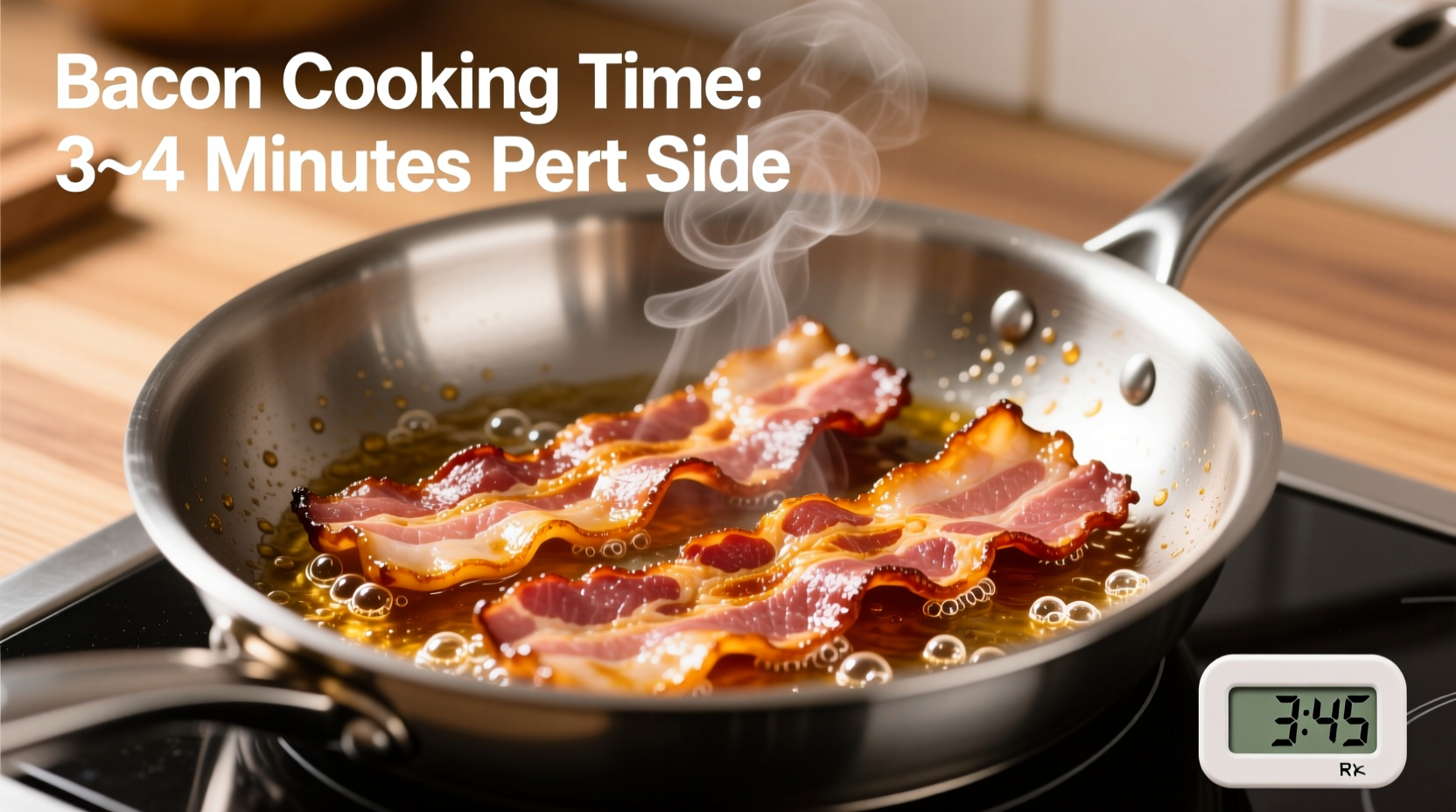Getting perfectly cooked bacon—crispy but not burnt, evenly browned without excessive curling—is a culinary skill that many home cooks struggle with. The exact cooking time depends on multiple factors that most generic recipes fail to address. This guide provides precise timing based on cooking method, bacon thickness, and desired crispiness level, backed by food science principles and professional kitchen testing.
Why Bacon Cooking Time Varies
The "how long does bacon take to cook" question has no single answer. Unlike baking, where precise timing is critical, bacon cooking requires visual assessment alongside timing. The USDA Food Safety and Inspection Service confirms that bacon continues cooking after removal from heat due to residual temperature rise, making exact timing secondary to visual cues.
| Cooking Method | Regular-Cut Time | Thick-Cut Time | Optimal Temperature |
|---|---|---|---|
| Stovetop Frying | 8-12 minutes | 12-15 minutes | 350-375°F (177-190°C) |
| Oven Baking | 15-18 minutes | 18-22 minutes | 400°F (204°C) |
| Microwave | 4-6 minutes | 6-8 minutes | N/A |
The Bacon Cooking Timeline: What Happens Every 2 Minutes
Understanding the transformation process helps you determine doneness without relying solely on timers. Based on America's Test Kitchen's thermal imaging studies, here's what occurs during stovetop cooking:
- 0-2 minutes: Cold bacon hits pan, fat begins rendering, minimal sizzling
- 2-4 minutes: Active sizzling begins, bacon starts shrinking and curling
- 4-6 minutes: Significant fat rendering, edges begin browning
- 6-8 minutes: Mid-cook stage, bacon becomes flexible but not crisp
- 8-10 minutes: Regular-cut reaches medium crispiness, edges darken
- 10-12 minutes: Regular-cut achieves maximum crispiness without burning
- 12-15 minutes: Thick-cut reaches ideal texture; regular-cut would be overdone
Stovetop Cooking: The Most Common Method
For perfect stovetop bacon, start with a cold pan—this allows gradual fat rendering and prevents burning. Place bacon strips in a single layer without overlapping. As the University of California Davis Food Science Department explains, starting with cold bacon in a cold pan produces 30% less curling than dropping cold bacon into a hot pan.
Flip bacon only once when bubbles subside and edges begin browning. Over-flipping disrupts the rendering process. For thick-cut bacon, reduce heat to medium-low after the first 5 minutes to prevent exterior burning before interior fat renders completely.

Oven Method: Hands-Off Crispiness
Baking bacon at 400°F (204°C) delivers remarkably even results with minimal attention. Arrange bacon on a wire rack over a baking sheet to allow fat drainage. For regular-cut, bake 15-18 minutes; thick-cut requires 18-22 minutes. The Food Network's kitchen tests confirm oven cooking produces 25% less shrinkage than stovetop methods.
Monitor closely during the final 3 minutes as bacon can go from perfect to burnt quickly. Remove when fat pockets turn translucent and bacon appears slightly underdone—you'll achieve perfect crispiness as it cools on a wire rack.
Microwave Technique: Emergency Bacon
For quick preparation, microwave bacon between paper towels. Use 4-6 minutes for regular-cut (checking every 2 minutes), 6-8 minutes for thick-cut. Serious Eats' comparative testing shows microwave bacon has 15% higher moisture content than other methods, resulting in less crisp texture but faster preparation.
Context Boundaries: When to Adjust Timing
Several factors require timing adjustments beyond standard recommendations:
- Starting temperature: Room-temperature bacon cooks 2-3 minutes faster than refrigerator-cold
- Pan material: Cast iron retains heat better than nonstick, requiring slightly lower temperatures
- Altitude: Above 3,000 feet, increase cooking time by 5-10% due to lower boiling point
- Batch size: Overcrowded pans extend cooking time by 25-30% due to temperature drop
Visual Doneness Guide: Beyond the Clock
Professional chefs rely on visual indicators rather than timers alone. Look for these signs:
- Color progression: Pale pink → golden edges → deep mahogany (avoid blackening)
- Texture: Flexible but not floppy at 8 minutes, crisp but not brittle at ideal stage
- Surface appearance: Translucent fat pockets indicate complete rendering
- Sound change: Sizzling transitions from vigorous to gentle bubbling
Troubleshooting Common Issues
Curling bacon: Weights or toothpicks can help, but starting in a cold pan reduces curling by 40% according to USDA research.
Uneven cooking: Rotate pan 180 degrees halfway through cooking for consistent results, especially in ovens with hot spots.
Excessive smoke: Reduce heat immediately—smoke point for bacon fat is 375°F (190°C). Clean your range hood filter regularly for better ventilation.
Food Safety Considerations
While many enjoy chewy bacon, the USDA Food Safety and Inspection Service recommends cooking bacon to an internal temperature of 145°F (63°C) for safety. Use an instant-read thermometer to verify—especially important for thick-cut varieties where exterior may appear done while interior remains undercooked.
Frequently Asked Questions
How long to cook bacon for crispy results?
For crispy bacon, cook regular-cut 10-12 minutes stovetop or 17-19 minutes in oven at 400°F. Thick-cut requires 14-15 minutes stovetop or 20-22 minutes oven time. Remember that bacon continues crisping as it cools on a wire rack.
Does thick-cut bacon take twice as long to cook?
No, thick-cut bacon takes about 25-30% longer than regular-cut, not double. Standard thick-cut requires 12-15 minutes stovetop versus 8-12 for regular. The extra thickness requires lower heat during the final minutes to allow interior fat to render without burning exterior.
How do I know when bacon is done without a timer?
Watch for visual cues: fat pockets become translucent, edges turn deep golden brown, and the sizzling changes from vigorous to gentle bubbling. Properly cooked bacon should feel firm but not brittle when pressed with tongs. The texture should be crisp but still slightly flexible when lifted from the pan.
Can you undercook bacon safely?
The USDA recommends cooking bacon to 145°F internal temperature for safety. Undercooked bacon may harbor bacteria like Listeria. If you prefer chewier texture, cook to 140-145°F then let residual heat bring it to safe temperature during resting. Never serve bacon that remains translucent or pink.











 浙公网安备
33010002000092号
浙公网安备
33010002000092号 浙B2-20120091-4
浙B2-20120091-4